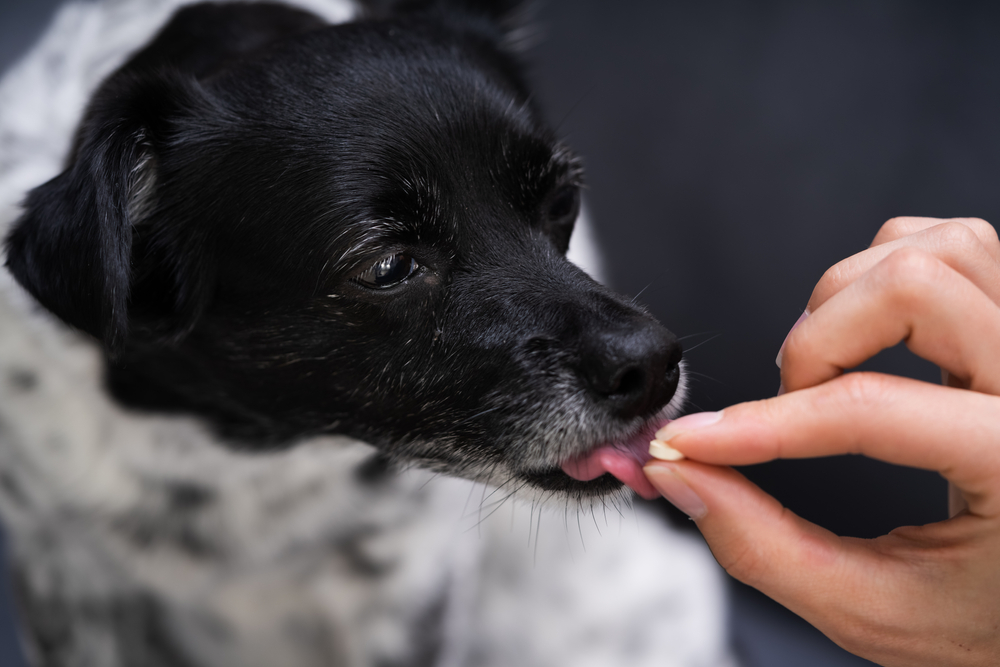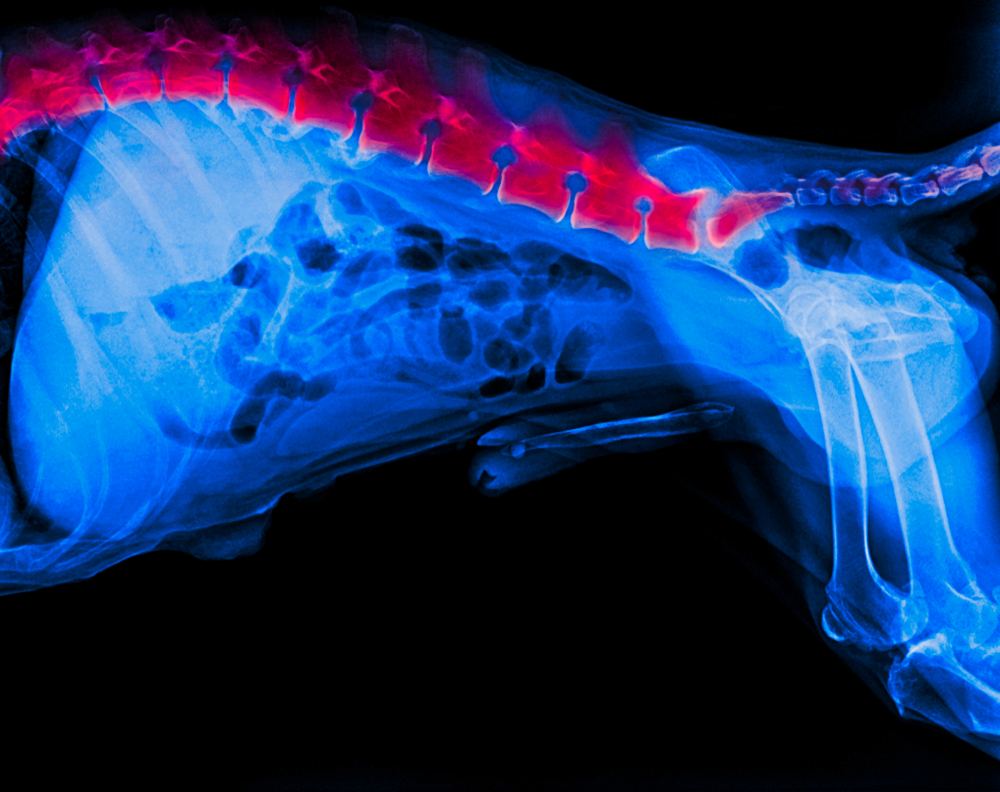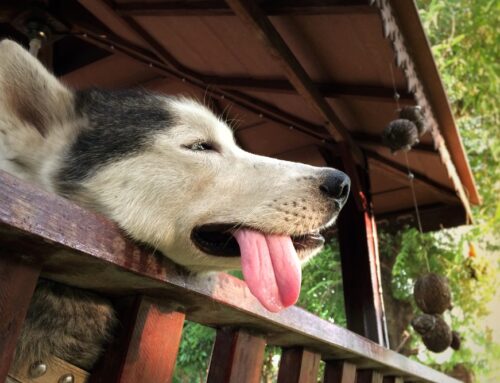Intervertebral disc disease (IVDD) is a common neurological problem that can cause pain and mobility issues in affected dogs and can occur in the cervical (i.e., neck), thoracic (i.e., chest), lumbar (i.e., lower back), or lumbosacral (i.e., pelvic) areas. Disease that occurs in the cervical and thoracolumbar regions affect the spinal cord, while disease that occurs in the lumbosacral region affects the cauda equina, a collection of large nerves that appear like a horse’s tail. Our Stack Veterinary Hospital team provides information about IVDD in case your dog is affected.
Dog intervertebral disc disease types
Numerous small bones (i.e., vertebrae) house and protect the spinal cord. Dogs have seven cervical vertebrae, 13 thoracic vertebrae, seven lumbar vertebrae, and three sacral vertebrae. Between the vertebrae are intervertebral discs that cushion the vertebral bodies. The intervertebral discs are composed of a fibrous outer shell (i.e., the annulus fibrosus) and a jelly-like center (i.e., the nucleus pulposus). Two main disease types can affect the intervertebral discs:
- Hansen type I disc disease — IVDD type I occurs when the nucleus pulposus calcifies, and the hardened material extrudes through the annulus fibrosus and puts pressure on the spinal cord and surrounding tissue. This type is commonly seen in dachshunds.
- Hansen type II disc disease — IVDD type II is a slow, degenerative process that occurs over months or years, where the annulus fibrosus collapses, and disk material protrudes and impinges on the nerves and spinal cord. This type is commonly seen in German shepherds.
Dog intervertebral disc disease signs
IVDD signs depend on the spinal region affected. Signs include:
- Cervical disc disease signs — The most common clinical sign is severe neck pain, and affected dogs may carry their head low and have a hunched posture. These dogs typically avoid handling, since neck palpation can cause extreme discomfort. The spinal canal in the cervical region is relatively wide, so neurological deficits occur infrequently, but can include front limb lameness or paresis.
- Thoracolumbar disc disease signs — Dogs affected in this area typically exhibit a hunched upper back and may be reluctant to run or jump. These dogs tend to experience less dramatic pain than dogs with cervical disc disease, but they may exhibit pain when picked up or when the affected area is palpated. Neurological deficits are more common in thoracolumbar disc disease, ranging from mild hind limb incoordination to complete hind limb paralysis. Bladder and fecal incontinence may also occur.
- Lumbosacral disc disease — Dogs affected by lumbosacral disc disease experience pain when their lower back muscles are palpated. They also may have difficulty rising from a lying position, and many experience extreme pain if their tail is manipulated. In some cases, bladder and fecal incontinence can occur.
Dog intervertebral disc disease diagnosis
When a dog presents with back pain, diagnostics must be performed to determine the cause and the lesion location. Tests include:
- Neurological examination — Our veterinary team assesses your dog’s gait and posture and tests different reflexes to determine the lesion location and disease stage.
- X-rays — We may take plain X-rays to rule out other potential causes and identify calcified discs or narrowed disc space. The disc herniation location can be determined using plain X-rays in about 50% to 75% of cases.
- Advanced imaging — Our veterinary team may recommend myelography, an imaging technique that involves injecting dye around the spinal cord, if we can’t identify the disc herniation on plain X-rays.
Dog intervertebral disc disease treatment
IVDD can be treated medically or surgically, depending on the disease severity. General rules when making this decision include:
- If your dog can walk and isn’t experiencing severe pain, medical treatment is a reasonable choice.
- If your dog can’t walk, but has deep pain perception in at least one limb, they have an 83% to 93% chance of recovery after surgery.
- If your dog can’t walk, has no deep pain perception, but has been down for 48 hours or less, they have a 50% to 60% chance of recovery after surgery. Their prognosis worsens significantly after 48 hours, and surgery may not help their situation.
Dog intervertebral disc disease medical management

IVDD medical management involves reducing spinal cord edema, providing pain relief, and attempting to prevent disc material further impinging on the spinal cord. Therapies include:
- Strict confinement — Affected dogs must be kept in a cage or a pen for at least three weeks.
- Medications — Our veterinary team may prescribe steroids, non-steroidal anti-inflammatories (NSAIDs), muscle relaxants, or pain relievers.
- Physical therapy — Physical therapy can help improve circulation and restore function. Different exercises are employed, depending on your dog’s recovery phase.
Dog intervertebral disc disease surgical management
Surgical intervention is the treatment of choice in IVDD patients who experience neurologic deficits using different techniques based on lesion location. The goal is to decompress the spinal cord and remove the herniated disc material.
IVDD is a concerning condition, and affected dogs should be treated as soon as possible to improve their prognosis. If your dog is experiencing neck or back pain, contact our American Animal Hospital Association (AAHA)-accredited team at Stack Veterinary Hospital right away, so we can ensure they receive the prompt care they need.







Leave A Comment